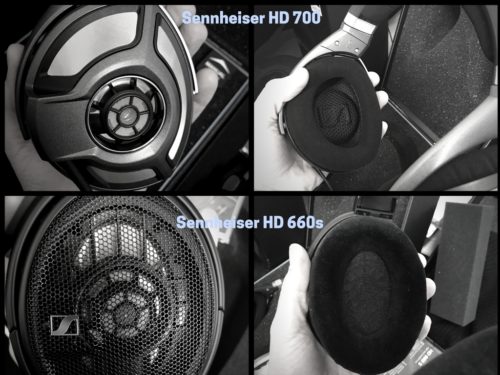Sennheiser’s new release of the HD 660s has us thinking a lot about the HD series headphones. These headphones are often the subject of hot debate, and it leaves us wondering how the 660s plays against each contender. Today, I’m going to listen to the HD 660s side-by-side to the HD 700 to see which is better. Here is a full Sennheiser HD 660s vs Sennheiser HD 700 comparison review.
Sennheiser HD 660s vs Sennheiser HD 700 Comparison Review
Specifications
| Sennheiser HD 660s | Sennheiser HD 700 | |
|---|---|---|
| Frequency Response | 10 Hz-41 kHz | 8 Hz- 44 kHz |
| Impedence | 150 ohms | 150 ohms |
| Type | open-back, over-ear | open-back, over-ear |
| Sensitivity | 104 dBSPL/1mW | 105 dBSPL/1mW |
| Drivers | dynamic | dynamic |
| Price | $499.95 | $749.95 |
In the Box
| Sennheiser HD 660s | Sennheiser HD 700 | |
|---|---|---|
| removable cable with 1/4” connector | removable cable with 1/4” connector | |
| removable cable with Penaconn (5-pin) connector | documentation | |
| 1/4” to 1/8” adapter | nice hard shell carrying case | |
| documentation | ||
Design
Comfort
Similarities
Just by looking at the Sennheiser HD 660s and the Sennheiser HD 700, it is easy to see a few similarities right away. Both models utilize a lot of padding, which makes me think they’ll both be quite comfortable. Both headbands also have a similar shape and they both have the same amount of flexibility and swivel.
Differences
I place the headphones on my head one at a time and notice that the Sennheiser HD 660s hugs the head tighter than the Sennheiser HD 700. I also feel a difference in the cushions, as the coating of the cushions is different between each headphone. The HD 660s cushion coating feels like a lower thread count velvet material, while the HD 700 is coated with a much higher thread count that feels softer. It feels like it is something between velvet and suede.
Durability
Similarities
Both Sennheiser models come with detachable cables. This feature contributes to the overall durability of the headphones because if the cable gets tugged, it will either pop out of the headphone or, if it breaks, it can be easily replaced without having to replace the whole headphone.
Differences
The major difference in durability on the headphones themselves is focused on the headband. The HD 700 has a thicker headband that is coated with a softer plastic, almost rubbery material that feels much more durable than the HD 660s headphones’ rigid plastic headband. Additionally, the HD 700 has a flimsier cable (according to folks on the internet). I didn’t personally have trouble with it but I saw many reviews claiming the cable was no good and needed replacement within a month or two of being purchased. It is coated with clothe whereas the HD 660s cable is not. The HD 660s also comes with an extra cable and an adapter, unlike the HD 700.
Style
Similarities
Both headphones are open-back and over-the-ear. They also both have similar sized and shaped headbands.
Differences
The HD 700 has asymmetrical, D-shaped earcups and earpads. On the other hand, the HD 660s has oval-shaped symmetrical earcups and earpads.

Sound
Sennheiser HD 660s
The Sennheiser HD 660s is not a reference headphone. It emphasizes various frequency ranges in the spectrum. Most notably, there is a boost at 3.5kHz which makes vocals sit upfront and clearly. A cut at 6kHz and another boost at 12kHz are present. As a result, these headphones tend to get harsh and aggressive when listening loudly and are unforgiving to recordings that are too bright.
The thickness in the high-mids makes the thinness of the low-mids especially bothersome. Finally, there is a boost around 150Hz, giving kick drums in particular a little extra umph.
Despite these accents, the headphones have a wonderfully detailed soundstage and a fast response to dynamic changes. It is particularly fun to listen to classical music on these headphones, because the headphones represent the intense emotional changes well in the form of detailed dynamics. Likewise, all genres benefit from the wide and deep soundstage. While the headphones give life particularly to spacious recordings, they lack height because of their uneven treble response. The boost at 12kHz is overpowering and doesn’t leave much room for the high, airy frequencies to extend the overall image’s tallness.
Sennheiser HD 700
Immediately I notice the Sennheiser HD 700 has much more space in the high frequencies. While there is still a boost at around 12kHz, the sound isn’t as intense or crowded there. The high-mids are thick, but this thickness balances with a thickness in the low-mids as well.
While the frequency spectrum feels more natural overall, the soundstage is not as accurate as the HD 660s. It does not have as much width or depth, but it does improve the height greatly!
The headphones sound nice with just about any genre, although I’ll admit it feels less dynamically responsive than the HD660s. Because of the frequency response, things are certainly easier to hear, but they are more difficult to feel.
Overview
To my surprise, the Sennheiser HD 660s and the Sennheiser HD 700 are very different headphones. While their sound signatures are similar, their strengths and weaknesses are pretty much opposite each other. The HD 660s has a better soundstage overall and the HD 700 has a more balanced frequency response. Whatever is more important to you should be the one you choose.
Both headphones are available for the best price here:
Sennheiser HD 660s at Audio 46
MajorHiFi may receive commission through retail offers.
MAJORHIFI may receive commissions from retail offers.








